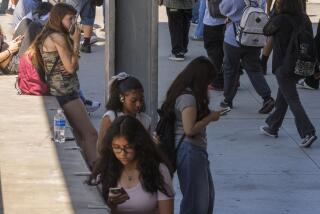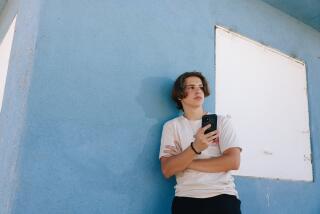Sexting may be the new normal for many teens, researchers say

Sexting may be part of the new normal for teenagers who are on the verge of becoming sexually active, new research shows.
Teens who told researchers they had sent naked pictures of themselves to someone in 2011 were nearly one-third more likely to be sexually active in 2012 than teens who had sent no such messages the year before, according to a study published Monday by the journal Pediatrics.
However, teens who sent explicit photos of themselves in email or text messages were no more likely than other teens to report having had many sexual partners in the previous year; to have had sex without a condom; or to have used drugs or alcohol before having sex.
“That we did not find any link between sexting and risky sexual behavior over time may suggest that sexting is a new ‘normal’ part of adolescent sexual development and not strictly limited to at-risk adolescents,” wrote the researchers, who are from the University of Texas Medical Branch in Galveston.
The study was an attempt to solve the chicken-and-egg problem regarding sexting and sex. Plenty of research has found that people who do one also do the other.
But most studies of sexting behavior ask about both things at the same time, so it’s hard to know which came first. Perhaps sexting is “a way of introducing sex into [a] relationship,” the researchers wrote. Alternatively, “it may be that having sexual relations increases the level of comfort in sharing nude images.”
To see which came first, Jeff Temple and Hye Jeong Choi examined data from an ongoing study called Dating it Safe. More than 1,000 teens were enrolled in 2010.
In 2011, when the average age of study participants was 16, they were asked whether they had ever “sent naked pictures of yourself to another through text or email.” They were also asked whether someone had asked them to send such a picture, and whether they had requested a naked picture from someone else.
Then, in 2012, the teens were asked whether they had ever had sexual intercourse. Compared with teens who didn’t sext in 2011, those who did were 1.32 times more likely to have had sex in 2012, the researchers found.
On the other hand, teens who merely asked for a sext or were invited to send a sext but didn’t were no more likely than others to be sexually active a year later, according to the study.
Future research should examine the role of sext messages that involve “explicit messages” and “seminude content,” the researchers concluded.
For the latest news about medical research, follow me on Twitter @LATkarenkaplan and “like” Los Angeles Times Science & Health on Facebook.







